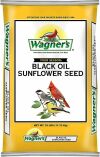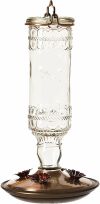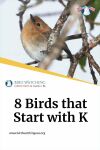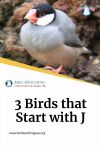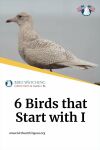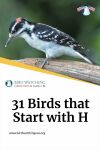
Introduction
Are you a curious bird lover? If you’re on a mission to enlist the most common birds in the USA and Canada, I can help you out. Right here we have the most common birds that begin with the letter H. Well, there are around 31 out of a total of the 750 most seen birds. At 4%, these birds are quite diverse - from gorgeous grebes and stunning sparrows to even beautiful woodpeckers!
I’ve arranged the list in descending order. But all credit goes to eBirds.com as without their data, nothing would have been possible. So let’s have a quick look at these birds, beginning from the ones that you’re most likely to see!
| House Finch | 24.18% |
|---|---|
| House Sparrow | 19.23% |
| Hairy Woodpecker | 8.19% |
| House Wren | 8.05% |
| Herring Gull | 7.21% |
| Hermit Thrush | 3.76% |
| Hooded Merganser | 3.58% |
| Horned Lark | 2.17% |
| Horned Grebe | 1.64% |
| Hooded Warbler | 1.03% |
| Hutton’s Vireo | 0.82% |
| Hooded Oriole | 0.67% |
| Heermann’s Gull | 0.47% |
| Harris’s Sparrow | 0.41% |
| Harlequin Duck | 0.32% |
| Hammond’s Flycatcher | 0.25% |
| Harris’s Hawk | 0.20% |
| Hermit Warbler | 0.20% |
| Henslow’s Sparrow | 0.15% |
| Hepatic Tanager | 0.11% |
| Hudsonian Godwit | 0.09% |
| Hawaii Amakihi | 0.07% |
| Hawaiian Coot | 0.05% |
| Hoary Redpoll | 0.04% |
| Horned Puffin | 0.04% |
| Hawaiian Goose | 0.03% |
| Hawaii Elepaio | 0.03% |
| Hawaiian Hawk | 0.01% |
| Hawaiian Duck | 0.01% |
| Hawaii Creeper | 0.01% |
| Hawaii Akepa | 0.01% |
It’s all in the details though for every bird watcher. So let’s dive further into each bird, along with some cool birdwatching tips. I’m sure that all the breathtaking pictures will leave you speechless because they certainly had that impact on me!
1. House Finch
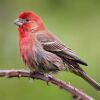
We have this red-headed house finch for a winner at #1. And guess what? Its voice is as cheerful as its colorful feathers. Look for its redhead, for the vibrant tone will stand out against any shade of green in mother nature.
Attracting the house finch to your backyard is quite easy. You can watch it forage on the ground if you have weeds or even a bunch of shrubs and trees grown. But you can maximize your chances by installing a bird feeder too. All you have to do is fill it with tiny black sunflower seeds. They just love to feast on flowers in the Spring. When it’s summer or winter though, you can expect them to move more towards small fruits - berries are their favorite! Don’t forget to place sugar-feed in hummingbird feeders too.
Here are sunflower seeds I highly recommend.
Wagner's Four Season Black Oil Sunflower Seed
20-pound bag consisting of thin-shelled sunflower seeds. You can feed these to a variety of birds of small breeds.
Another tip though. You better watch out if you have a lot of vegetation in your outdoor space. House finches have a huge appetite for vegetables, speaking from personal experience! But you can do what I did and provide a sort of covering to protect the veggies.
Keep your ears open for a chirping sound. Since they sound like house sparrows, you may get confused between the two.
fun fact
expect more birds
Let the drama begin once you attract a house finch! Once these finches get attracted to your bird feeder, they spread the word. So you can expect flocks of other bird species too.
2. House Sparrow
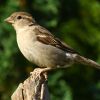
Speaking of the house sparrows, look who made it to #2 on this list! You can find these sparrows in both urban and country landscapes. Perhaps it’s hiding in the corners of a building. Maybe you’d come across one sitting on the rooftop of the barn.
Wherever they might be, you can easily spot these sparrows by their exciting hops. They’re not as picky as other birds when looking for something to eat. From feeding on alive and dead insects to getting food from bird feeders, the diet of house sparrows is quite diverse and adaptable.
Next, you can fill the feeder with any sort of food. Although personally, I recommend corn and sunflower seeds. These sparrows also enjoy sucking out nectar from flowers. So imagine the number of house sparrows that can come over to your garden if you have plenty of flowers blooming!
If you want to learn more about the different types of bird feeders, have a look here .
fun fact
dust baths
Don't worry if you haven't got a birdbath in your backyard! House sparrows can even bathe in dust and they love it. It has the ability to clean every bit of its feathers by throwing dust and soil over itself. They can even defend the deep hole they end up making by this act.
3. Hairy Woodpecker
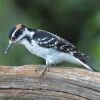
On #3 we have the hairy woodpecker!
They simply love peanuts, and black oil sunflower seeds, Want to know another unusual fact about the diet of a hairy woodpecker? They don’t back off from eating dead plants or dead parts of a tree. They even like to breed in a dead tree.
You can also put up a bird feeder if you don’t have dead plants in your backyard. I personally had a small tree that was close to dying. It was safe as it wasn’t that big, it didn’t pose danger to my home. However, once the hairy woodpecker left the tree after breeding, other cavity-nesting birds came over to own the place!
Hairy woodpeckers love foraging on trees as well, and even on shrubs and vines. They have a huge diet for insects, especially the eggs of wood-boring beetles. You’ll also see them enjoying the sap of trees!
Also, apart from its pecking, look out for its sharp and loud ‘peek’ call!
fun fact
oldest hairy woodpecker
The oldest hairy woodpecker recorded was a male of 15 years, 11 months old.
4. House Wren
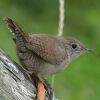
We have the lovely House Wren at #4! You can hear them singing with high notes at first, that gradually decline. Check if you can hear a lively song that sounds like a series of bubbles and gurgles.
Also, you can think about setting up a nest box to attract a pair of House Wren birds. You would need to put up a guard to protect it from potential predators - larger birds can attack and eat the eggs and young ones of the House Wren.
I’ve got a garden full of bushes and shrubs. Whenever I cut and prune them, I gather all the leaves in a pile. These birds love to visit heaps of leaves, so it’s a great idea if you can do that! If you have dense vegetation, you can expect these precious songbirds to pay you a visit. While they forage on the ground, they love to look for insects on trees as well. They eat anything from grasshoppers to caterpillars and moths and even spiders.
fun fact
the temperature of the nest box
The eggs of a House Wren need moderate temperature to survive. The nest box shouldn't go above 106 degrees Fahrenheit, nor should it go below 65 degrees Fahrenheit. The eggs can become useless in either case.
5. Herring Gull
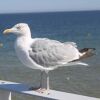
On #5 we have the super awesome Herring Gull! These birds have plenty of ways to forage. You can find them flying, swimming, and even walking to fulfill their omnivorous diet. They can feed on marine life such as fish of various sizes, crustaceans, and even sea urchins.
Like other gulls, you’re most likely to find a Herring Gull along coastlines and shores. In the winter, you can even expect to see them inland. They love to stay near any type of huge body of water. The best way to identify Herring Gulls is through their loud kuk-kuk rollicking calls.
fun fact
bait-fishing
Adult herring birds often baitfish. You may be able to see one throwing pieces of bread into the water to attract fish and other sea creatures. These clever birds don't even eat the bread afterward!
6. Hermit Thrush
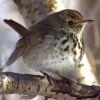
Next up is the Hermit Thrush on #6!
These tiny birds aren’t attracted to bird feeders. But if your backyard has shrubs and berries, you can expect the Hermit Thrush to pay you a visit. They feed on a variety of berries in winter and their diet can also include grapes. You can find them foraging on the ground as well, looking for insects like caterpillars, earthworms, grasshoppers, and spiders.
You can also recognize this bird by its melodious song. You can often find the males singing this flute-like melody in the morning or in the evening. When Hermit Thrushes are around their nests, they even make sounds similar to that of a kitten. Although their calls and songs are charming, they sometimes sound mournful too!
fun fact
creative at nest-making
Trees and grounds are common places for the Hermit Thrush to have its nest. However, these little birds are creative and make their nest in the strangest of places. You can look for them on tombstones, in mines, and even on golf courses.
7. Hooded Merganser
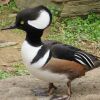
On #7 we have the Hooded Merganser!
These stunning birds like to live near shallow lakes. They use their feet to forage by swimming and diving to feed on marine life. You can find them feasting on fish, crustaceans, and even tadpoles.
There is a chance you could attract hooded merganser to your backyard. But for that to happen, you must be living close to their natural habitat. Just set up a nest box and fill it with wood shavings to make it cozier and more welcoming. If you live near a lake, you could attract a breeding pair of Hooded Merganser birds.
fun fact
second-smallest in the family
We currently have a total of six species of mergansers alive. The Hooded Merganser is the second-smallest of them all!
8. Horned Lark
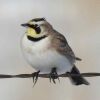
On #8 we have the Horned Lark! This small bird looks like a soft cotton ball with light brown feathers and a yellow patch on the chin!
These birds like to roam in large open fields. The feathers in their body look a lot like soil. So you can help look for them using the pop of yellow and black on their head instead. You can find them on large patches of brown ground. You can find them foraging by walking or running in such areas, looking for seeds and insects.
Their summer diet is mostly made up of many critters and crawlers, these can include snails and spiders. During the winter, these birds are more attracted to plants, especially berries.
Also keep your ears open to any ti-ti like song. When in flight, the horned larks give high-pitched calls.
fun fact
the female begins to dust-bath
Usually, the female begins a dust bath to attract a potential mate and announce that it's ready to breed.
9. Horned Grebe
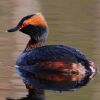
Next up on #9 we have the Horned Grebe! Its one of my favorite birds because of its distinct and vibrant red eyes. The bright orange-brown feathers on its head also add to the pop!
If you live in North America, you may catch sight of these birds near coastlines or bodies of water such as lakes and rivers. You can find them in flocks at such places, especially when they’re migrating in April and October.
In winter, you can head to the South-East of the United States. Their winter diet is mostly made up of fish and overall, they love to feed on marine life. They can even swallow feathers! Regardless, they’re solitary hunters when it comes to food, so it’ highly unlikely that you find them foraging in flocks.
You can hear their trilling calls while they’re breeding! You can also hear them shrieking at breeding grounds, otherwise, they’re almost always silent.
fun fact
active chicks
Did you know that the chicks of the Horned Grebe also go underwater along with their parents? Apart from that, the backs of their parents.
10. Hooded Warbler
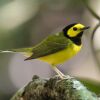
Look who we have on #10 - it’s the Hooded Warbler! Its bright yellow feathers with a touch of green and black are by far the most favorite combination. These birds mostly hop on the ground or in the leaves of shrubs and trees to look for insects such as flies, caterpillars, beetles, and grasshoppers.
I tried to use a bird feeder to attract the Hooded Warbler to my backyard. That didn’t quite work out as they don’t visit personal outdoor spaces quite often. These birds are fond of natural habitats so your best shot is to have a garden or backyard that has many shrubs and trees. You can also find a whole family of these birds in forests.
Since these birds are small, you can also listen for their voice. Pay close attention to whether you can hear any calls or songs with a rhythmic tee-tee.
fun fact
songs of male hooded warblers
Each male hooded warbler sings a song that's entirely his own. They learn to recognize where their neighbor bird's song is coming from.
11. Hutton’s Vireo
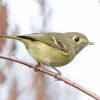
On #11 we have the Hutton’s Vireo! This tiny songbird has the most stunning green feathers you’ll ever come across. Listen to them chattering and whistling! They also sing songs that go like chu-wee, che-eer, or chit-chit.
Look for the Hutton’s Vireo along the coast of the Pacific Ocean. You can also go to the South-East of Arizona and look for these birds in the mountains. If you’re going in the winter, you’ll be able to watch them migrating with flocks of many other birds such as warblers and chickadees, among many others.
The best places for these birds are dense foliage and sometimes even on branches. You can find them hopping from one twig or branch to another, looking for insects to eat. Other than that, they’re quite fond of berries too!
fun fact
many subspecies
Can't get enough of the Hutton's Vireo? Around 12 subspecies of these birds can be found over a range of vast areas, typically separated by desert. And guess what? They're all of different sizes!
12. Hooded Oriole
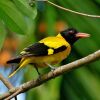
On #12 we have yet another yellow and black bird - the Hooded Oriole! Their songs sound jumbled up and they love to whistle as well. You better pay attention to their calls as sometimes they tend to hide whilst they sing.
It’s easy to attract these birds to your backyard. I was able to call over a Hooded Oriole by using an orange. You can cut out slices and put them out in the open where your feathered friend can see them. You can use other items such as jelly or sugar water, it’s best to place the water at a high position, like in a hummingbird feeder.
If you don’t know what sugar water is, just take four parts of water and dissolve one part of sugar in it. Also, remember that the orange must be completely fresh!
Ready to see a Hooded Oriole in your backyard? Well, here is a hummingbird feeder I highly recommend. Its antique look makes it an amazing house decor object too!
Crystal Clear Glass Hummingbird Feeder
It is a 10-ounce glass hummingbird feeder. Its crystal clear texture allows you to easily see the food. It has 4 flower feeding ports and brushed copper bases.
Other than that, they love to feed on insects and berries as well. They are quite slow to forage, yet their long pointed bills allow them to suck out the nectar of many flowers. They also eat insects such as ants, beetles, and wasps.
fun fact
nicknamed "palm-leaf oriole"
The Hooded Oriole loves to build its nests in palm trees. Therefore, it has been given the nickname "Palm-Leaf Oriole". It's the female that makes holes in the leaves and then attached the nest via sewing.
13. Heermann’s Gull
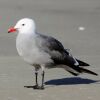
On #13 we have the Heermann’s Gull! It tends to give kuk-kuk-kuk calls like any other gull. But you can also hear it giving a high-pitched ‘see-whee’ type sound from time to time.
The best time to look for Heermann’s Gull is between June and September. You’ll find plenty of these birds along the coast of the Pacific Ocean. The best places are ones that are rich in kelps or areas with sandy beaches. I myself found flocks of them near a beach! During the breeding season though, you can find them in Mexico’s Gulf of California.
Their diet is mostly made up of aquatic life. You’ll find them feeding on fish crustaceans and mollusks. But apart from that, you can also see them foraging the ground for insects.
fun fact
the oldest heermann's gull
The oldest ever Heermann's Gull recorded was a female that was 24 years old minimum. We can't say for sure what her maximum age was because she was released in 2009 (Oregon).
14. Harris’s Sparrow
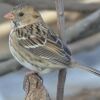
On #14 we have the extremely attractive Harris’s Sparrow! This sparrow often steals the spotlight thanks to the black patches above and below its pinkish beak.
To attract the Harris’s Sparrow to your backyard, set up a bird feeder with corn and black sunflower seeds. I did the same but I also put in a few millets in the mix and guess what? I was able to attract a beautiful pair of these birds. Another thing you can do is create an environment that these sparrows will love.
They love bushes so you’re in luck if your garden or backyard is full of them! You can also create heaps or piles of leaves that you get after pruning the bushes and shrubs. You’ll find them scratching on it with their feet. Perhaps they’ll do that when they want to feed on insects!
fun fact
breeding in Canada
The Harris's Sparrow is a North American songbird. However, they're also the only such kind to go to Canada for breeding. They don't go to any other place to breed!
15. Harlequin Duck
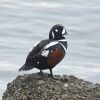
Next up on #15 is the Harlequin Duck!
If you head out to the North-West of the Pacific and the North-East of the Atlantic, you’ll find plenty of Harlequin Ducks waiting for you. Especially during the winter season, as they’ll gather in groups along the shores and coastlines of these regions. These ducks love to stay in rough conditions, so look out for places that are full of rocks and close to the ocean.
It’s also no wonder that this waterfowl bird will also spend time near rivers. I saw a couple of them in such an environment, looking forward to feeding on aquatic insects, accompanied by low whistling and mouse-like squeaking. At sea, they mostly eat marine worms, small fish, crustaceans, and mollusks.
fun fact
broken bones
Among all birds, Harlequin's Duck is the most likely to suffer from bone fractures all their lives.
16. Hammond’s Flycatcher
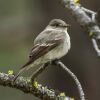
This flycatcher is my favorite because of it’s olive-green feathers and a 3-parted song that the males in these species completely own and rock. They can look very similar to Dusky flycatchers, but you can always recognize them by their song. The last part of the song is usually a rising note and pitch. Listen closely to detect a sweep-tsurp-seep call or rhythm - that’s the Hammond’s Flycatcher!
You should plan a trip to dense forests in the Spring and Summer. These flycatchers tend to sit still on perches, looking out for flying insects to catch mid-air. Once they spot flies and moths, they’re quick to fly out and grab them. Apart from that, they’re known to eat caterpillars, wasps, and even leafhoppers. Sometimes, they even attack from the ground but when I spotted my first one, it was sitting at a low-level branch.
fun fact
history of the name
Do you know why they call it the Hammond's Flycatcher? The species has been named after William Alexander Hammond, a U.S. military physician who was the first to discover this bird's specimens.
17. Harris’s Hawk
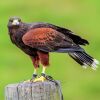
The Harris’s Hawk comes in next on #17 and it’s also my favorite one in the family of hawks! They are quite versatile when choosing habitats, so you can spot them sitting on man-made structures, rather than only perching on natural branches.
If you see one hanging around or in low-flight near bushes, it is probably hunting. They have quite a diverse non-vegetarian diet that includes tiny mammals, reptiles, smaller birds, and sometimes large insects as well They’re quite fond of squirrels and rabbits so if you have those as pets - I suggest you give them proper shelter!
It has a very low hiss, so it’s hard to recognize it by sound.
fun fact
playful young ones
The offspring of Harris's Hawk is playful and also has quite a sense of humor. You can find it jumping from one perch to another. It acts like it is out on a hunt, even when it really isn't!
18. Hermit Warbler
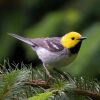
Look who is next on #18 - the Hermit Warbler! Its golden face reminds me of the sun, which is why this bird puts a smile on my face!
When I first came across this bird, I had heard it singing at first. It was the season of Spring when its high-note song caught my attention. You may want to keep your ears open for a soft ‘chup’ like rhythm. It’s usually the males that sing when they are breeding or trying to mark their territories. During the winter, they’re easiest to spot in the pine trees near Mexico. But regardless, it’s best to choose a hiking track that brings the top of the trees close to you on eye-level.
This bird is really hard to spot otherwise. Their favorite dwelling place is at the very top of tall trees. Especially canopy ones with dense textures, so you might want to end up bending your neck for that! Their diet is mostly made up of flying insects but they also eat spiders, beetles, and caterpillars.
fun fact
interbreeding
Did you know that some Hermit Warbler females mate with Townsend's Warbler males? However, interbreeding doesn't occur the other way around.
19. Henslow’s Sparrow
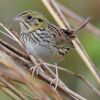
Welcome yet another sparrow on #19 - the Henslow’s Sparrow!
These sparrows are easy to spot since they mostly spend their time hopping around on the ground. Sometimes, it could be hard to see Henslow’s Sparrow as it could be hiding in thick grass. But most of the time, they like to walk and scan the ground for insects, which make up most of their summer diet. In the winter though, you can also see them eating weed, sedges, and even grass.
It sings a very unique song, that sounds like 2-note sneezing. See if you can hear any short ‘tsi-lick’ rhythms!
fun fact
they sing at night
Henslow's Sparrows are quite active singers! Not only do they sing at dawn and dusk, but sometimes they sing all night long as well.
20. Hepatic Tanager
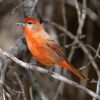
We have the absolutely stunning Hepatic Tanager at #20! It’s my favorite bird because of its gorgeous red orange feathers. They look no less than flames, do they?
You have plenty of opportunities to observe it whilst foraging because of its slow pace. They are most likely to feed on insects, but keep a few plants in their diet too, especially berries! Though when I saw a Hepatic Tanager once in late summer, it was happily eating wild grapes. It’s best to look for them in the mountains of Arizona during both Spring and Summer.
And not only does this bird look beautiful, but it also sings like a gem. You can recognize its soft song that sounds like a fusion of short phrases and whistles.
PRO-TIP
unrelated species
Did you know that there are around more than 300 species of tanagers in South and Central America? However, the 4 species in the USA and Canada are completely unrelated to the others.
21. Hudsonian Godwit
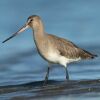
On #21 we have the beautiful Hudsonian Godwit!
These birds migrate in the Spring so you can look for them in any open ocean space. You can also check them out on the Upper Texas coast. But your best bet of finding them is over the Atlantic and Pacific oceans, and also along their coastlines. Also look for them in open rice fields, as you can find them in flocks in such environments. If you live in Kansas, you’ll find them there too, as they can be found in that region, along with in Saskatchewan and the Dakotas.
I saw one of these foraging by walking in the water. They prefer shallow water reservoirs over deep ones. I was also quite amused to see that its head went completely underwater whilst looking for marine insects to eat inland. They use their bills to probe the mud and during migration, you’ll find them toward the outer shores than in the inland, looking for fish, crustaceans, and mollusks to eat.
fun fact
migration to south America
Did you know that the Hudsonian Godwit flies for thousands of miles for post-breeding migration? They start their flight from the subarctic and don't stop till they reach South America!
22. Hawaii Amakihi

We have the bright yellow Hawaii Amakihi at #22!
The Hawaii Amakihi is a small honeycreeper that you can find in the various islands of Hawaii. Go look for these birds in the forests of Maui, Molokai, and Hawaii. You can find this bird in a variety of habitats - anywhere from above 8000 feet to even sea level.
As for their diet, they prefer to eat a variety of insects. They’re used to foraging in different places and environments. Sometimes, you can find these birds drinking fruit juice, tree sap, or flower nectar. In other moments, you’ll find that they use their decurved bull to look for spiders and other insects in tree barks and heaps of leaves. They can even eat fruit pulps!
The Hawaii Amakihi are also an endangered species, along with a couple of other Hawaii birds.
fun fact
where the name comes from
The word 'Amakihi' stems from 'kihi', which means 'curved'.
23. Hawaiian Coot
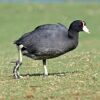
Next up is the Hawaiian Coot at #23!
As its name suggests, this bird is the only coot you’ll find in the Hawaiian islands. It looks very similar to the American coot. This medium-sized bird enjoys staying around wetlands. After all, it has an appetite for tadpoles and aquatic leaves. It also feeds on a couple of invertebrates.
So you can find these birds across all Hawaiian islands. You can find them easily in Molokai, Hawaii, Maui, Oahu, Niihau, and Kauai. But make sure to look in the lower areas because of their love for wet environments!
fun fact
Hawaiian culture
This bird was regarded as a sort of deity in Hawaiian culture. Yet, it was also considered ideal for eating.
24. Hoary Redpoll
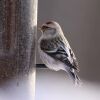
We have the Hoary Redpoll on #24. These birds are quite similar to common redpolls.
In the summer, you’ll be able to find the Hoary Redpoll very easily if you head to the High Arctic. I noticed a couple of them walking around in that region. But you’ll have to be very patient if you want these birds to visit your backyard though. Sometimes they might make an appearance with common redpolls, but that’s also a rare event. In the winter, you can find these birds in the north most regions of the continent. They are quite fond of being around humans, so you might even find them sitting on people’s heads now and again!
In flight, their calls are sharp metallic sounds. But when they’re busy feeding on the ground, you can hear them twittering softly. Also look for its red head, as that would make it easier for you to spot this cute bird.
fun fact
storing seeds in pouches
All redpolls can store seeds in their esophagus. They have pouches there that allow them to store seeds and delay eating until they're in a much safer location.
25. Horned Puffin
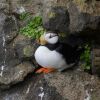
On #25 is the magnificent Horned Puffin!
You’d have to plan a trip to the Pribilof Islands if you want to see horned puffins. Although it’s rare some birdwatchers that have traveled in the winter, have been able to spot these puffins in the Pacific Ocean. I found a couple of these puffins swimming underwater, sometimes coming to the surface. They love to feed mostly on small fish, but many adult horned puffins love to eat crustaceans, marine worms, and squids.
fun fact
nest-building on cliffs and in rocks
The majority of the puffins build their nests in burrows. However, the Horned Puffin prefers to build nests on cliffs and on the top of rash rocks.
26. Hawaiian Goose
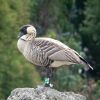
On #26 we have the Hawaiian Goose! This mighty goose is the official state bird of Hawaii! You can recognize it by the unique feathers on its neck.
The Hawaiian Goose is not found in all of the Hawaii islands though. You’ll be able to look for it in Maui, Kauai, and Hawaii. You can find its nests in both sparsely and densely vegetated lands. So you can find pairs of the Hawaiian Goose even in the surrounding areas of volcanoes. They have a vegetarian diet and they eat almost anything in plants, even flowers that grow on grasses. Seeds, leaves of shrubs, and berries are also amongst their favorites.
fun fact
endangered species
The Hawaiian Goose ranks sixth on the list of most endangered waterfowl birds.
27. Hawaii Elepaio
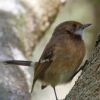
Up next on #27 is the Hawaii Elepaio.
You can find this cute little bird in the forest regions of the Hawaii Islands. It has a very sweet call and song, so listen closely. You can hear it repeating its name ‘elepaio’ in both calls and songs. Their voice is very sweet and melodious. Also, look for trees where insects are in abundance. These birds love to sit in the branches and catch insects as they find them.
fun fact
upright tail
The Hawai'i Elepaio often sits with its tail upright. In this position, their tails are clearly visible. Look for a black tail, that appears dashing against its white and rusty brown feathers.
28. Hawaiian Hawk
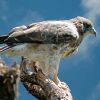
Moving on to #28, we have the Hawaiian Hawk.
You find the Hawaiian Hawk only on Hawai’i Island. However, sometimes, these hawks often wander to the surrounding islands of O’ahu, Kaua’i, and Maui. Your best bet is to find these birds on the Hamakua Coast near volcanoes. These hawks tend to love a variety of environments, so you can find them in pastures, forests, and anywhere as long as it’s within the island.
fun fact
Hawaiian legend
This hawk is a symbol of royalty in Hawaiian legend. In Honolulu, there's a palace of the Hawaiian Monarchy, which was also given the name 'Iolani' or the 'exalted hawk'.
29. Hawaiian Duck
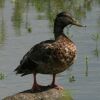
Next up we have the Hawaiian Duck on #29.
The Hawaiian Duck is also known as the Koloa Maoli. The history of this duck dates back almost ten thousand years. You cannot find it anywhere else in the world, so you’d definitely have to plan a trip to Hawaii. It’s kind of sad though that interbreeding and a number of other factors (like hunting) have endangered this bird.
fun fact
hybridization research
But here's the good news. Although this duck is endangered, the latest hybridization research has shown phenomenal results. The levels of interbreeding and hybrids have fallen to an all-time low!
30. Hawaii Creeper
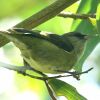
We have the Hawaii Creeper on #30 of this list. It is a small honeycreeper bird that you’ll find exclusively only in Hawaii. You can watch it pecking on the bark of trees to take out insects. Like the Hawaiian Duck, this bird also used to be very common once upon a time, but for now, it is endangered. It’s a very close ancestor of the house finch and probably descended from the rosefinch as well. Their calls either sound like a “dee-dee-dee” or a “wheet”.
fun fact
Group of honeycreepers
Do you know what a group of honeycreepers is called? It is known as a hive! It's all in the name.
31. Hawaii Akepa
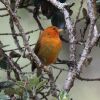
And so, we end our list at #31 with the Hawaii Akepa. This bird is also a kind of honeycreeper that you can only find on the islands of Hawaii. Although there is a bit of difference between the birds in Hawaii and Maui. The Hawaii Akepa male has vivid orange-red feathers, whereas the one in Maui is duller and has yellowish-bronze feathers.
These tiny birds love to hang out in wet forests elevated from the ground. Their diet is mostly made up of caterpillars but they love to feed on other insects as well. Also, pay attention to its song which is sort of a descending trill and has short notes that sound like “kee-wee” or “kee-ah-wee”.
fun fact
cavity-nesting
The Hawaii Akepa is very picky when it comes to nesting. It only chooses cavities that already exist. And the trees that it chooses are either Ohia or Koa.
Conclusion
So those are the 31 most common birds in the USA and Canada that start with the letter H. Which ones have you seen before and did any of these make it to your list of favorites? Don’t forget to follow our birdwatching tips as you set out to see each bird on this list.
Oh, and if you want to learn about the most common birds that start with the letter I, read this post .
6 Birds that Start with I
Did you know that out of the 750 most common birds in the USA and Canada, there are only 6 that begin with the letter I?

By David A. Swanson
Bird Watching USA
My name is David and I'm the the founder of Bird Watching USA! I started Bird Watching with My father-in-law many years ago, and I've become an addict to watching these beautiful creatures. I've learnt so much over about bird watching over the years that I want to share with the world everything I know about them!

David A. Swanson
Bird Watching USA
My name is David and I'm the the founder of Bird Watching USA! I started Bird Watching with My father-in-law many years ago, and I've become an addict to watching these beautiful creatures. I've learnt so much over about bird watching over the years that I want to share with the world everything I know about them!

